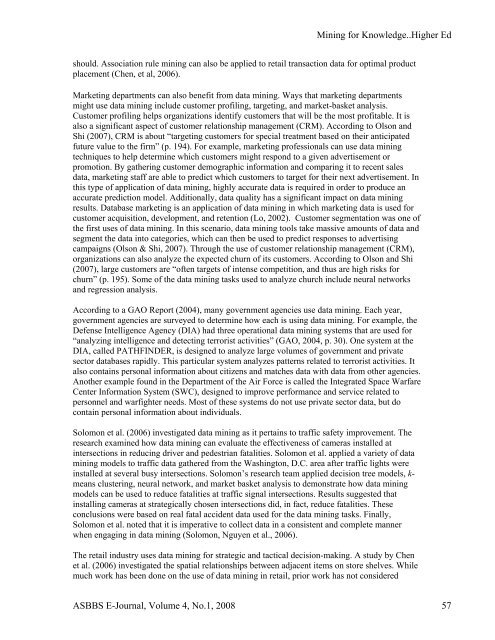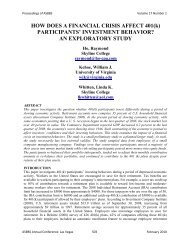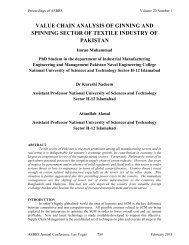stock repurchase announcements: a test of market ... - Asbbs.org
stock repurchase announcements: a test of market ... - Asbbs.org
stock repurchase announcements: a test of market ... - Asbbs.org
Create successful ePaper yourself
Turn your PDF publications into a flip-book with our unique Google optimized e-Paper software.
Mining for Knowledge..Higher Ed<br />
should. Association rule mining can also be applied to retail transaction data for optimal product<br />
placement (Chen, et al, 2006).<br />
Marketing departments can also benefit from data mining. Ways that <strong>market</strong>ing departments<br />
might use data mining include customer pr<strong>of</strong>iling, targeting, and <strong>market</strong>-basket analysis.<br />
Customer pr<strong>of</strong>iling helps <strong>org</strong>anizations identify customers that will be the most pr<strong>of</strong>itable. It is<br />
also a significant aspect <strong>of</strong> customer relationship management (CRM). According to Olson and<br />
Shi (2007), CRM is about “targeting customers for special treatment based on their anticipated<br />
future value to the firm” (p. 194). For example, <strong>market</strong>ing pr<strong>of</strong>essionals can use data mining<br />
techniques to help determine which customers might respond to a given advertisement or<br />
promotion. By gathering customer demographic information and comparing it to recent sales<br />
data, <strong>market</strong>ing staff are able to predict which customers to target for their next advertisement. In<br />
this type <strong>of</strong> application <strong>of</strong> data mining, highly accurate data is required in order to produce an<br />
accurate prediction model. Additionally, data quality has a significant impact on data mining<br />
results. Database <strong>market</strong>ing is an application <strong>of</strong> data mining in which <strong>market</strong>ing data is used for<br />
customer acquisition, development, and retention (Lo, 2002). Customer segmentation was one <strong>of</strong><br />
the first uses <strong>of</strong> data mining. In this scenario, data mining tools take massive amounts <strong>of</strong> data and<br />
segment the data into categories, which can then be used to predict responses to advertising<br />
campaigns (Olson & Shi, 2007). Through the use <strong>of</strong> customer relationship management (CRM),<br />
<strong>org</strong>anizations can also analyze the expected churn <strong>of</strong> its customers. According to Olson and Shi<br />
(2007), large customers are “<strong>of</strong>ten targets <strong>of</strong> intense competition, and thus are high risks for<br />
churn” (p. 195). Some <strong>of</strong> the data mining tasks used to analyze church include neural networks<br />
and regression analysis.<br />
According to a GAO Report (2004), many government agencies use data mining. Each year,<br />
government agencies are surveyed to determine how each is using data mining. For example, the<br />
Defense Intelligence Agency (DIA) had three operational data mining systems that are used for<br />
“analyzing intelligence and detecting terrorist activities” (GAO, 2004, p. 30). One system at the<br />
DIA, called PATHFINDER, is designed to analyze large volumes <strong>of</strong> government and private<br />
sector databases rapidly. This particular system analyzes patterns related to terrorist activities. It<br />
also contains personal information about citizens and matches data with data from other agencies.<br />
Another example found in the Department <strong>of</strong> the Air Force is called the Integrated Space Warfare<br />
Center Information System (SWC), designed to improve performance and service related to<br />
personnel and warfighter needs. Most <strong>of</strong> these systems do not use private sector data, but do<br />
contain personal information about individuals.<br />
Solomon et al. (2006) investigated data mining as it pertains to traffic safety improvement. The<br />
research examined how data mining can evaluate the effectiveness <strong>of</strong> cameras installed at<br />
intersections in reducing driver and pedestrian fatalities. Solomon et al. applied a variety <strong>of</strong> data<br />
mining models to traffic data gathered from the Washington, D.C. area after traffic lights were<br />
installed at several busy intersections. Solomon’s research team applied decision tree models, kmeans<br />
clustering, neural network, and <strong>market</strong> basket analysis to demonstrate how data mining<br />
models can be used to reduce fatalities at traffic signal intersections. Results suggested that<br />
installing cameras at strategically chosen intersections did, in fact, reduce fatalities. These<br />
conclusions were based on real fatal accident data used for the data mining tasks. Finally,<br />
Solomon et al. noted that it is imperative to collect data in a consistent and complete manner<br />
when engaging in data mining (Solomon, Nguyen et al., 2006).<br />
The retail industry uses data mining for strategic and tactical decision-making. A study by Chen<br />
et al. (2006) investigated the spatial relationships between adjacent items on store shelves. While<br />
much work has been done on the use <strong>of</strong> data mining in retail, prior work has not considered<br />
ASBBS E-Journal, Volume 4, No.1, 2008 57

















